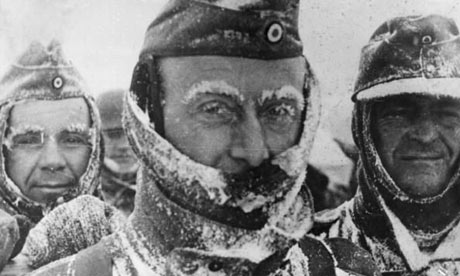
The
negligence of Adolf Hitler, to not appreciate the topographical and climatic
conditions of Stalingrad and its environs,
resulted a faulty decision responsible for the subsequent annihilation of the
German Sixth Army.
Topography:
To reach Stalingrad , German forces had to travel over one thousand
miles through hostile, foreign territory. The distance affected not only the
communication and supply lines but also the psychological effects of the
soldiers who felt overwhelmed by the vastness of the Russia Russia
Another big
problem was the harsh climatic conditions in the Stalingrad
region. During the summer the temperature can reach 30 degrees centigrade,
which can make the soldiers fatigue increase during the long marches. During
autumn, there was so much rain that even tanks couldn’t pass the mud. And
during the winter the temperatures were too low and everything seams to
freezing.
 |
| A russian soldier that captured a german soldier |
Der Kessel (supply problems)
With his army
trapped inside a ring of Soviet armor, Paulus informed Hitler that he only had
6 days of food for his troops. One of the finest armies in history was about to
die from starvation, disease and exposure. Hitler promised to re-supply the 6th
Army from the air. Luftflotte 4 didn't have that many aircraft on hand and a
good portion of what they did have was down for maintenance. Von Richthofen
pressed He-111 bombers into service as transports and struggled to maintain
what effort he could. Soviet fighters now controlled the corridors his planes
used to approach Stalingrad and the daily toll of aircraft was mounting.
Soviet fighters attack and went to controlled the corridors of supply planes used to approach Stalingrad. Also the severity of the Russian winter made flying impossible on some days and nothing would reach Paulus' forces. Quite often a transport would crash while attempting to land.
Despite Richthofen's best efforts, the airlift never had a remote chance of success. The lack of airplanes, the horrible flying weather and the distances involved doomed it from the outset. Richthofen's appeals for more aircraft, Hitler started to collect every available airplane in Germany and the occupied countries into service for the airlift. Pilot fatigue, improperly trained aircrew, ice and Soviet fighters soon left a trail of downed aircraft strewn across the steppe on the approaches to Stalingrad. As the
airlift mission failed, Paulus cut his troops rations in an effort to conserve
food. As ammunition began to be depleted, 6th Army's capacity to resist were
decaying.

The 6th Army's fuel and ammunition situation had deteriorated to the extent that most heavy equipment, trucks and armor would have had to be abandoned. Whatever the case, Paulus was not about to proceed with an evacuation without Hitlers permission. Hitler steadfastly refused to consider the withdrawal of 6th Army from Stalingrad, saying that without their heavy guns and armor such a retreat could only have a "Napoleonic ending".
Conclusion of Geographicall Challenges:
Winter in Russia was one reason of why the airlift supply mission failed.
Severe
weather conditions, over stretched supply lines, unfavorable terrain, causes
the German Sixth Army to defeat and annihilation

0 comments:
Post a Comment